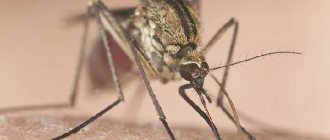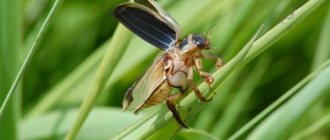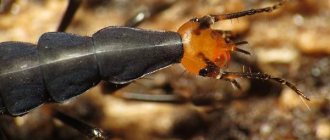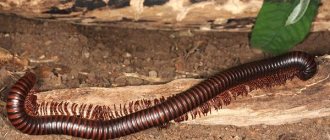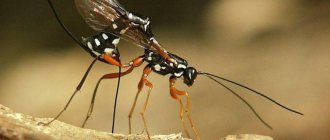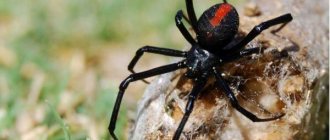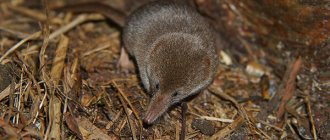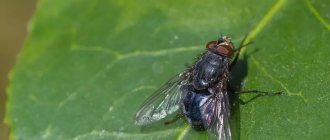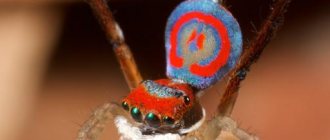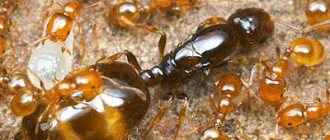Types of mosquitoes
There are more than three thousand species of mosquitoes. In the article we will consider the most common varieties that people most often encounter. Not all of the known and widespread mosquitoes in our area drink blood. Let's find out which mosquitoes can cause harm to humans, and which are completely harmless.
Common mosquito (squeaker)
An adult squeak mosquito reaches 7 mm, the legs are long, the wings are narrow and transparent, the body color is gray. They belong to the species Culex. Females are superior to males in body size and antennae length. In males, the proboscis is not so developed as to pierce the skin of a mammal, so the basis of their diet is plant foods. Only females bite and drink lymph. The life cycle of a mosquito does not exceed 48 days. The habitat and reproduction are places with high levels of humidity. This species is especially common in the central zone of our country.
Malaria mosquito (Anopheles)
Anopheles (malarial mosquito) is especially dangerous for humans, as it carries parasites and viruses that cause severe pathologies: plasmodium and malaria. In size they practically do not differ from ordinary representatives of this family. The only peculiarity: long hind legs. The habitat of this mosquito is places near bodies of water, since reproduction is possible only in the presence of an aquatic environment.
Centipede mosquito (Karamor)
The centipede mosquito can reach a length of 8 cm, so it is often confused with the malaria mosquito. Karamor is the largest species in the world. It lives in places with high levels of humidity: near water bodies, in forest thickets and in swamps. This type of mosquito is not dangerous for humans, since the insect’s diet consists exclusively of plant foods. However, this species can cause significant damage to agricultural crops. This is especially true for larvae, which are extremely gluttonous.
Winter mosquitoes (Chionea)
In addition to the Karamora, winter mosquitoes differ from the above species by their impressive size. The basis of their diet is products of decomposing plants. They do not pose a danger to humans, since they are not among the blood-sucking insects. Adults can reach sizes up to 2 cm. They do not disappear all year round, so they can be seen even in the cold season.
Tiger mosquitoes
It is distinguished by the presence of white stripes on the body and legs, larger size and darker color. Habitat: subtropics and tropics. They are aggressive. They are carriers of dangerous infectious diseases, for example, dengue or yellow fever, and therefore pose a danger to humans. The basis of the diet of mosquitoes of this species is the blood of mammals. The bites are very painful.
Stinging mosquitoes
An adult stinging mosquito reaches 12 mm. The habitat of insects of this species is forest thickets. The color of the insects is beige-yellow, there are dark spots on the wings, and white rings on the legs. Females differ from males in having a long proboscis and shaggy antennae. Stinging mosquitoes pose a danger to humans, as they spread a serious disease - tularemia.
Mosquito Dergun
The habitat of these insects is dense vegetation on the shores of small bodies of water. The lifespan of mosquitoes of this species is no more than 5 days. For humans, the jerk mosquito does not pose a danger, since it feeds exclusively on plant foods. The adult is dark brown in color with relatively long legs.
Anatomy of a mosquito
Although biologists still do not know enough about the habits, lifestyle and reproduction of mosquitoes, how a mosquito works is already known quite well. It turned out that such a “primitive” creature already has almost all the internal organs that higher mammals have.
The morphological description of mosquitoes is similar. All insects of this family have a thin body, the length of which varies depending on the species and can be from 4 to 14 mm. All mosquitoes have long legs and a pair of transparent, narrow wings. The wingspan also, depending on the species, can be from 5 mm to 3 cm. Main types of coloring:
- yellow;
- grey;
- brown.
Among mosquitoes there are species with black or green coloring.
Body structure
A mosquito consists of a head, chest and abdomen. The chest of insects is wider than the abdomen, which consists of 10 segments. The mosquito has 3 pairs of legs attached to the chest.
On a note!
After feeding, the abdomen swells, becoming wider than the chest.
Head
Structure of a mosquito's head
On the head are located:
- compound eyes;
- antennae;
- oral apparatus.
The compound structure of the eyes provides the bloodsucker with all-round visibility and helps avoid danger. Mosquitoes have infrared vision, so they can perfectly see the approaching danger in the form of a palm.
The antennae consist of 15 segments, the first of which are quite wide. The first segment is attached directly to the head. The second contains the so-called Johnston's organ, which supposedly plays the role of a mosquito's ear.
Interesting!
In mosquitoes, the easiest way to distinguish a female from a male is by the structure of the antennae.
The segments following the first two are called the scourge. The segments of the female's whip have almost the same cylindrical shape. There are a few short hairs on them. The male has conical segments and the hairs are longer and thicker. This is noticeable even without a microscope, as the male’s antennae appear fluffy. Since the structure of a mosquito, even today, has not yet been fully studied, it is assumed that the antennae serve mosquitoes to analyze air movement and partially replace their missing nose.
The mosquito's mouthparts are of the piercing-sucking type. It consists of 3 pairs of sharp needles, covered with a flexible cover. 2 pairs are stilettos. The outer ones are also equipped with a “file” to facilitate piercing the skin. There are also chitinous bristles that act as mosquito teeth. The internal pair are hollow tubes, through one of which the insect drinks blood, and through the other it injects its poison. The flexible cover has no other function other than protecting the mosquito's trunk from damage.
On a note!
But only the female mosquito has such a complex structure. The male's mouthparts are underdeveloped, which is why he can feed exclusively on flower nectar.
With a very small head, the mosquito’s brain is large enough for an insect, but is formed by the connection of two longitudinal nerve trunks. The trunks run parallel to each other along the lower surface of the chest and abdomen, connecting at the head above the pharynx. The main brain is supplemented by ganglia. These are large nerve nodes located in each segment of the mosquito's chest and abdomen. It is the ganglia that coordinate the work of all organs of the insect. Nerve endings diverge from these nerve nodes to the organs.
Breast
Anatomy of a mosquito
It looks like a single mass, but in fact it consists of 3 unevenly developed segments:
- prothorax;
- mesothorax;
- metathorax.
The most strongly developed is the middle part, to which the mosquito's wings are attached. She also carries all the flying muscles.
The long neck of the insect is formed by the prothorax. The middle one is responsible for the bloodsucker’s ability to fly and breathe. It contains the mosquito's anterior spiracle. The metanotum is relatively poorly developed. Its main purpose is to provide breathing. It contains the posterior spiracle.
The mosquito's legs are attached to the chest segments. There are 3 pairs of them according to the number of segments. Each foot has 5 segments. The latter is equipped with a suction cup and claws, allowing the insect to stay on vertical surfaces and “hang upside down” on the ceiling.
Interesting!
The legs of mosquitoes are longer than the body, and the back pair is particularly long. Why an insect needs such a device, similar to the structure of the legs of a water strider, is not clear. But this may be an atavism.
The bloodsucker once had 4 wings. Today there is only one pair of workers left. All that remained of the second pair were the rudiments of the halteres, due to which the females emit their characteristic squeak.
Interesting!
Males do not make sounds.
The wing is a transparent oval-elongated plate consisting of frame veins and a membrane between them. The wings are covered with small scales. For the most part, the scales are transparent. But there are bloodsuckers with colored scales. In this case, the accumulation of colored scales forms a spot. In “green” and “black” colors such spots form a pattern.
Abdomen
Consists of 10 segments. The internal structure of the abdomen is more complex than just a reservoir for drunk blood. It contains:
- a significant part of the digestive tract;
- appendages to the digestive tract;
- heart.
Appendages (crops) take the place of the main tract while it is empty. When the stomach is filled with blood, the insect releases the crops from the contents.
Digestive tract
The structure of a mosquito
The internals of mosquitoes that are familiar to us begin right from the head. The bloodsucker's mouth is connected to the foregut, which includes a pharynx that has two extensions: before the “brain” and after it. The foregut has several appendages: 3 esophageal appendages and 2 salivary glands. Neither the foregut nor the esophageal appendages perform a digestive function. The appendages serve the insect to ensure its independence from water and food. These are “food warehouses” with reserves of carbohydrates and water.
When the mosquito needs food, the “warehouse reserves” enter the stomach, where their absorption begins. The hindgut consists of a small intestine and a rectum. Almost the entire digestive tract is located in the mosquito's abdomen.
Circulatory system
Insects do not have a closed circulatory system, and the pumping of blood and lymph is carried out due to the work of the heart and diaphragm.
A mosquito does not have a heart as we are familiar with it. It is devoid of chambers and is a muscular tube located in the abdomen between the 1st and 7th segments. The heart can pump blood from the front end of the insect to the back end or vice versa.
At the border with the chest, the heart passes into the aorta, which passes through both anterior sections and opens into the head cavity.
Interesting!
These insects' own blood is colorless.
How is a female mosquito different from a male?
Almost all insects of the same species differ from each other in their body structure, depending on their gender, and mosquitoes are no exception. Main differences:
- Male mosquitoes have bushy, bushy antennae. The female's antennae are much smaller and practically invisible, because she does not have to look for a partner.
- The female common mosquito has a well-developed mouthparts, with which she bites the skin and sucks blood, thereby providing herself with food. The male feeds on plant foods, so his mouthparts are simpler and not adapted for piercing and sucking blood.
- The sensory abilities of female mosquitoes are more developed. They need this to find a donor. Male squeak mosquitoes do not have these characteristics because they do not need to search for prey.
In addition, the lifespan of a female is twice that of a male.
Differences between a male mosquito and a female
It turns out that female mosquitoes are larger and weigh about 2 mg. At the same time, they are the smallest insects in nature. The female has a proboscis with which she bites and drinks blood. Instead, the mosquito has several fluffy antennae. When biting, the female secretes saliva, so the bite site itches and burns. The mosquito does not see well, but can find a person by the carbon dioxide that he exhales.
How do mosquitoes reproduce?
The mating behavior of mosquitoes is called “eurygamy.” Males form a swarm and wait for females. With their sensitive antennae, they detect the subtle squeak of the females’ wings, which they emit during the mating season. A female caught in such a “cloud” of male mosquitoes becomes the sexual partner of the one who first manages to latch onto her with his appendages and fertilize her. After fertilization, females go in search of a donor in order to obtain enough nutrients from the blood that are necessary for laying eggs.
The most suitable places for mosquitoes to lay eggs:
- the surface of a weakly flowing or standing body of water;
- moist soil on the shore;
- objects floating on the water (leaves, twigs).
A high level of humidity is important to maintain egg viability. The female lays eggs every 2-3 days. Each clutch contains 30-150 pieces. The most prolific female mosquitoes are capable of laying up to 300 eggs at a time.
A few days later, larvae hatch from the laid eggs. There are species of mosquitoes that leave eggs throughout the winter. The larva develops in about 20 days, going through four stages of molting, after which it turns into a pupa. This process directly depends on the temperature of the habitat. Adults are formed 7-14 days after the last molt. In some cases, the formation process may take up to a month.
What do male mosquitoes eat? How to distinguish them from females?
It seems like everyone knows that only female mosquitoes bite and drink blood. But what do male mosquitoes do at this time and what do male mosquitoes generally look like? For many this remains a mystery. I will try to lift the veil of secrecy over this issue.
This entry is from the Yaran sketches series. Photos were taken at a macrophotography master class at the end of May 2013 near Yaransk.
It is unlikely that in our country you can find a person in whose life there was not a moment when he cursed and wished the disappearance of the entire mosquito family. On a summer evening, especially near standing water, clouds of mosquitoes can be very annoying. Swooping in whole hordes, they are ready to risk their lives to get blood. Dying in hundreds, they return in thousands.
Since only female mosquitoes bite, we found out how to distinguish them from males? Male mosquitoes also have a proboscis, but it does not contain a piercing apparatus capable of piercing human skin. The main difference between a male mosquito and a female mosquito is its luxurious, lush mustache. Unlike the thin “twigs” of the female, the male’s mustache is somewhat reminiscent of the soft down feathers of birds. This can be seen in the photos above and below.
Mosquitoes accumulate their main energy reserves during the larval stage, while they live under water. To maintain their existence, adult males and females of most mosquitoes need flower nectar. From its carbohydrates, mosquitoes synthesize glycogen, which stores energy and is actively consumed during flight. This occurs in a special organ called the fat body. You can see how a mosquito drinks nectar from a flower in the photographs below.
Females, in addition to carbohydrates, require proteins, iron and lipids, which are most easily obtained from the blood of mammals and birds. All this is required for an important process: females must lay eggs and take care of the continuation of the mosquito family. The mosquito usually drinks blood for no more than 3 minutes, drinking only 2-4 microliters of blood (a microliter is a millionth of a liter).
Having drunk blood, the female hides in some secluded place, where she digests this portion of blood for several days. At the same time, eggs mature in her body. The duration of this process depends on the ambient temperature. In hot weather, a couple of days is enough, and in cool weather, ripening can take a week and a half. Afterwards, the female looks for a pond where she will lay from one to several hundred eggs. Under favorable conditions, if the mosquito is lucky and is able to drink blood again, this process can be repeated up to four times during the mosquito’s short life.
It remains to deal with the last question: why do mosquito bites itch so much? The mosquito saliva, which they inject immediately after the bite, contains painkillers that allow you not to feel the proboscis stuck into the body for some time. But immediately at the moment of the injection, the pain is felt well. To combat this, mosquitoes use carbon dioxide, which stuns pain receptors for a split second and prevents blood from clotting until anesthetic and anticoagulant saliva is introduced. Symbiotic microorganisms, yeast, that live in the mosquito’s esophagus help produce this gas. Along with mosquito saliva and carbon dioxide, the yeast itself enters the wound. They cause an allergic reaction - itching and swelling at the site of the bite. This is due to the fact that the human body’s immune system has long been accustomed to fighting foreign yeast in the intestines that enters there with food. Don't think that this is related solely to dough and bread. Yeast is quite common in nature, living on fruit peels, leaves, and many other places, almost anywhere there are substrates rich in sugars.
I hope this post will be useful to someone, clearing up some of the confusion associated with these buzzing bloodsuckers.
Additional materials:
- Blood-sucking mosquitoes A.P. Sadchikov, professor at Moscow State University
- These amazing mosquitoes on apus.ru
- Real mosquitoes on Wikipedia
Life cycle of a mosquito
Regardless of the species, the life cycle of mosquitoes follows a similar pattern and consists of four stages:
- Egg - once every 2-3 days, the female is able to lay 30-150 units. Ripening occurs within a period of 2 days to a week.
- The larva hatches from the egg and continues to develop, living in a body of water and feeding on microorganisms living in it. Breathing is carried out through a special tube.
- The pupa is formed after going through four molts. The development period in the aquatic environment is up to 5 days. As it matures, it acquires a black tint.
- Imago is the stage of development when the pupa turns into an adult mosquito, whose life activities continue on land.
What do mosquitoes eat and why do they bite?
The diet of mosquitoes mainly consists of food of plant origin. Blood-sucking females are ectoparasites. Certain species must obtain sufficient valuable substances from the lymph in order to lay eggs. Thus, mosquitoes obtain food from two sources: plants and mammals. Blood and plant foods are a source of carbohydrates - energy. In lymph, the content of useful substances is much higher: fats (lipids), proteins. The latter is the main material for egg production.
How does a mosquito bite and drink blood?
Having discovered the donor, the female lands on his skin, clinging with tiny claws. She quickly pierces it with her sharp jaws. The female lowers her proboscis deeply into the resulting hole so that it reaches the capillaries. With its help, it absorbs blood, which contains many nutrients. The process takes no more than a minute. As it becomes saturated, the insect's body increases in size and the abdominal walls gradually stretch.
However, before starting to suck blood, the female mosquito injects her saliva with coagulants in its composition. They help slow down blood clotting, thereby facilitating the absorption process.
What diseases do blood-sucking mosquitoes carry?
Blood-sucking insects spread viruses, bacteria and parasites. Let's look at what diseases mosquitoes carry:
- Malaria. The carrier is a malarial species. When infected with this disease, fever and joint aches are observed. A dangerous disease can even lead to death.
- Tularemia. Up to 250 cases of infection are recorded annually. The disease is characterized by fever, severe headache, weakness and aching joints. The carriers are mosquitoes and biting mosquitoes.
- Japanese encephalitis. In our country, you can become infected in the Primorsky Territory. The symptoms of a dangerous illness in the form of fever, weakness, headache, manifest themselves sharply. Carried by common mosquitoes.
- Meningitis. When infected, weakness, fever, severe headache, and clouding of consciousness occur. In the absence of adequate therapy, it can lead to serious complications. In 10% of cases it ends in death.
- Filariasis. Mosquitoes can introduce larvae into the human body, from which they grow into nematode roundworms, which disrupt the functioning of the lymphatic system. The disease is accompanied by swelling, enlargement of any part of the body, and inflammation of the skin.
The benefits and harms of mosquitoes
In addition to the intrusiveness of parasites, there is a danger of infection from a bite. Together with the saliva of the squeak mosquito, some viruses can penetrate the human body - Japanese encephalitis, filariasis, meningitis, avian malaria. The skin puncture site causes unbearable itching. Bites are especially dangerous for allergy sufferers, who may develop various reactions in the form of hives, rashes and eczema.
At the same time, mosquitoes allow you to maintain the natural balance. Birds feed on adult insects, and the larvae are valuable food for aquarium fish. This menu is especially useful for juveniles, which grow quickly on environmentally friendly black bloodworms.
What causes a mosquito bite to itch?
Every person who has ever been bitten by a mosquito has experienced unpleasant symptoms: itching, redness and swelling. The appearance of such sensations is explained simply - by inserting her proboscis into the skin, the female mosquito injects two substances:
- An anticoagulant that slows down blood clotting, allowing the mosquito to drink the required amount of blood.
- An anesthetic that reduces sensitivity, due to which a mosquito bite may not be noticed.
The body perceives them as foreign and activates the immune system, which stimulates the release of special substances, trying to get rid of them. Their combination causes itching, and scratching the bite site only increases their generation. That is why it is recommended to endure it so as not to worsen the situation.
The importance of mosquitoes in nature
Mosquitoes bring not only harm, but also benefit. They are of great importance in nature. And their complete extermination can lead to irreparable consequences.
- Mosquitoes are food for many animals - birds, fish, and for frogs at certain times of the year they are the main food.
- While in the water, the larvae of these insects take many microelements from it. Having gone through all stages of development, the adult continues its life on land and, dying, enriches the soil.
- Male mosquitoes, feeding on nectar and plant sap, perform the important function of pollinating flowers.
- The larvae of blood-sucking insects provide food for various river inhabitants, for example, fish, spiders and other larger insects.
Mosquitoes are an important link in the food chain. It is with this insect that the next food chain begins: mosquito-frog-heron. And there are many such examples.
Mosquito behavior
We now know that only the female mosquito has a proboscis with which she can bite through the skin. What then does the male eat? All mosquitoes use water and nectar as food. This is the basis of their nutrition. They also collect food on amphibians, reptiles, frogs and snakes. But after mating, the female needs blood for further healthy offspring, because it contains the protein and energy components necessary for this. To search for a mammal - a possible victim, the female uses thermal and chemical sensors that react to the smell of sweat and the release of CO2, the presence of octenol and various chemicals. Turning into an adult, after 2 days the female makes her first bite.
Squeaking is made not only by females, but also by males. Their wing flapping speed is up to 500 beats per second; in the female, this sound is the highest. This is how the male determines where the female is. Therefore, when you hear a nasty squeak nearby, you should not think that it is a female; the male is also endowed with the same sounds.
When do mosquitoes appear and when do they disappear?
Most species of these insects hibernate during the cold season, and wake up only with the onset of the warm season. In other mosquitoes, the larvae remain throughout the winter and begin to hatch only in the spring. To do this, the temperature at night should not fall below +10 C. Mosquitoes begin to look for shelter to overwinter. The warmer it gets, the more active the insects become. Peak activity of mosquitoes occurs in summer.
As soon as a period comes when the temperature at night does not rise above +10 C, the insects begin to gradually disappear. Overwintering mosquitoes seek shelter for the winter. When the first frost sets in, they completely disappear.
Russia has a vast territory with different climatic zones, so blood-sucking insects can appear and disappear at different times. For example, in the southern regions they become active at the very beginning of spring, and in the northern regions not earlier than June. The duration of the active phase of insect life is also connected with this.
Where do mosquitoes live?
The places where mosquitoes live are characterized by high humidity and warm climates. Insects can be found everywhere, they are absent only in the eternally cold Antarctica. Distributed in areas with hot and temperate climates. Here they can live up to six months.
In temperate latitudes, insects hibernate during the cold winter period and awaken with the arrival of spring. They even live in the Arctic, during the warming period, which lasts several weeks, they reproduce with terrible force and get deer.
Females choose bodies of water to lay eggs, but the habitat must be studied. The water should have an average temperature, it should not be too cold and dirty. Its temperature should be +25-350C. The composition must contain organic and nutritious substances. They prefer small bodies of water that are not inhabited by predatory fish species.
How and where do mosquitoes winter?
The activity of insects directly depends on the air temperature of their habitat. When this indicator decreases significantly, for example, at the beginning of autumn, blood-sucking insects disappear because they lose the ability to reproduce.
- Mosquitoes remain for the winter in the area where they live. They don't fly to another country.
- Ideal places for mosquitoes to wait out the winter are cracks, crevices in walls, curtains, windows and other nooks and crannies.
In temperate latitudes during the cold season, insects' metabolism is almost completely inhibited, and their shape-forming and physiological processes are suspended. But this does not mean that the life of mosquitoes has completely stopped. Processes in the body of an adult individual, its eggs or larvae continue to occur, but much more slowly.
Geography of mosquito distribution
Despite the fact that mosquitoes are considered heat-loving insects, they live almost throughout the entire globe, with the exception of Antarctica. Most species live in warm climate zones. Many species are found in temperate latitudes. Even in the harsh climate of the Arctic, mosquitoes live. True, arctic insects are active only a few weeks a year. But this time is more than enough for them to reproduce numerous offspring.
More than 100 species of mosquitoes live in Russia. Among them is the common mosquito, otherwise called the squeak mosquito, which is deservedly considered the most widespread species on Earth, as it lives wherever people live.
What don't mosquitoes like? How to protect yourself from them?
Penetrating inside a person’s home, mosquitoes cause a lot of trouble. There are several effective ways to get rid of these annoying insects:
- Mosquito nets on windows and doors . As a rule, window structures are already equipped with them, but they can also be purchased separately. However, this method does not guarantee 100% protection against mosquitoes.
- Electric fumigants. By affecting insects, pesticide gases destroy them. To get rid of mosquitoes, just connect the device to the network.
- Repellents. Available in the form of sprays, creams and lotions. The products are made on the basis of substances that repel blood-sucking insects. They are applied directly to the skin.
Natural remedies cope well with this task. Mosquitoes do not like the smell emitted by tomato plants. By planting tomato bushes on a windowsill or balcony, you can get rid of annoying insects.
Insects are also repelled by the scents of Persian chamomile, geranium, lavender, cloves and chrysanthemum. Mosquitoes cannot tolerate the smell of pine needles. You can scare away annoying insects by placing spruce or pine branches in the room, setting fire to needles or coniferous bark, or using essential oils of spruce, pine, eucalyptus, juniper and cypress.
Mosquitoes do not like tobacco smoke, so insects rarely fly towards smokers. Insects try to avoid plants with a pronounced aroma: basil, thyme, anise, lemongrass, wheatgrass, wormwood and bird cherry.
